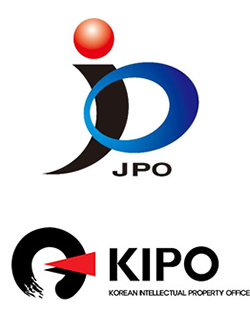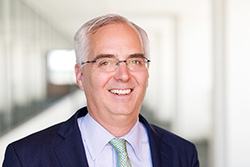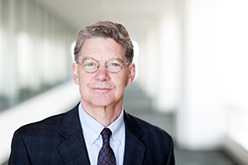USPTO
Launches Two Year Diversion Pilot Program
Cooperation
for an Expanded Collaborative Search Pilot with the JPO and KIPO
The USPTO is initiating a two-year Diversion Pilot Program for patent and trademark practitioners. Implemented by the Office of Enrollment and Discipline (OED), the program aligns USPTO with the practices of more than 30 state attorney discipline systems. It will help OED accomplish its mission of protecting the public from practitioners who fail to comply with the USPTO’s standards for ethics and professionalism.
To learn more, read the press release.
 The USPTO’s
Joseph Matal, Performing the Duties and Functions of the Under Secretary of
Commerce for Intellectual Property and Director of the United States Patent and
Trademark Office, participated in the signing of a bilateral Memoranda of Cooperation (MOC) with the Korean Intellectual Property Office (KIPO) and the Japan Patent Office
(JPO) on Oct. 1 and Oct. 2, respectively. Mr. Matal signed the MOC’s with
Dr. Sung Yunmo, Commissioner for the KIPO and Ms. Naoko Munakata, Commissioner for the JPO, to begin the
second phase of the bilateral Collaborative Search Pilot (CSP) program. The
MOC’s were signed at bilateral meetings held on the margins of the World
Intellectual Property Organization (WIPO) General Assembly in Geneva,
Switzerland.
To learn more, read the press release.
|
USPTO
Finalizes Revised Patent Fee Schedule
 The U.S.
Department of Commerce’s United States Patent and Trademark Office (USPTO)
today issued a final rule, “Setting and Adjusting
Patent Fees during Fiscal Year 2017” to set or adjust certain patent fees, as authorized by
the Leahy-Smith America Invents Act (AIA). The revised fee schedule is
projected to recover the aggregate estimated cost of the USPTO’s patent
operations, Patent Trial and Appeal Board (PTAB) operations, and administrative
services. The additional fee collections will support the USPTO’s progress
toward its strategic goals like pendency and backlog reduction, patent quality
enhancements, technology modernization, staffing optimization, and financial
sustainability.
To learn more, read the press release.
|
2017 Collegiate
Inventors Competition Winners Announced
 The future of American
innovation was on display Nov. 3 at the 2017 Collegiate Inventors Competition held
at the U.S. Patent and Trademark Office (USPTO) in Alexandria, Va.
Cutting-edge
inventions created by the nation’s brightest young innovators from colleges and
universities across the country – solving challenges from water decontamination
to wearable power generation – were showcased at the competition’s public expo,
providing the students a forum to answer questions and discuss their inventions
with USPTO patent examiners, patent attorneys, trademark examiners and senior
officials; corporate sponsors; members of the intellectual property community;
and the public.
Read
the blog from the Department of Commerce.
|
The Importance of
Independent Inventors to America – and America’s Economy
 Throughout history,
independent inventors have transformed our lives with their innovative ideas
and played a key role in the growth of the U.S. economy. Regardless of whether
these ideas spawned small family businesses or large corporations, the work of
small inventors is part of the fabric of American innovation. Think of names
like Dupont, Ford, Kellogg, and Wright; and technology such as the telephone,
the electric lightbulb, the steam engine, and the airplane. A disproportionate
number of the most important technological advances started in the minds of
small-scale, independent inventors, and their ideas have helped create new
jobs, businesses, and even entire global industries. Today, the importance of
small inventors and small business endures. According to the Small
Business Administration (SBA), two
out of three net new jobs in the U.S. are created by small businesses.
Read
the blog by
Joe Matal, Performing the Duties and Functions of the Under Secretary of
Commerce for Intellectual Property and Director of the USPTO.
|
Traveling with a
Group of Global IP “Rock Stars”
 I recently had the
opportunity to join several of the USPTO’s intellectual property (IP) attachés
in Long Beach, CA, to deliver presentations at the American Bar
Association’s (ABA) IP West Conference and meet with local U.S. stakeholders and
businesses.
The USPTO’s IP
attachés, who came here from their regional posts in South America, Central
America, Asia, Mexico, and the Caribbean, are U.S. diplomats assigned to
embassies or consulates to advocate U.S. positions on IP matters for the
benefit of U.S. stakeholders. They are committed to advancing U.S. business
interests internationally. They also provide information to U.S. businesses
entering foreign markets, including how to navigate foreign laws and protect
their IP abroad.
Read
the blog by John Cabeca, Director of the Silicon Valley
Regional U.S. Patent and Trademark Office.
|
Revised Patent Fee
Schedule Finalized
 The U.S. Patent and Trademark Office (USPTO) is
celebrating the culmination of a multi-year effort to secure the financial
security of the Patent and Patent Trial and Appeal Board (PTAB) organization in order to better serve the United States economy. We have made tremendous
progress reducing overall patent pendency, reducing our inventory of unexamined
applications, enhancing patent examination quality, reducing the ex parte
appeal inventory, and implementing the post-grant review proceedings
established by the Leahy-Smith America Invents Act (AIA), all of which are vital to ensuring steady domestic job growth. While great progress has been made, there is still
much to be accomplished, and additional funding will be needed. After years of
preparation, deliberation, analysis, and consideration of stakeholder opinion,
the USPTO issued a final rule, “Setting and Adjusting
Patent Fees during Fiscal Year 2017,”
using the fee setting authority of the AIA to
strategically change certain patent and PTAB fees.
The revised fee
schedule is projected to produce approximately 4% more patent revenue each
fiscal year once fully implemented.
Read
the blog by Commissioner for Patents
Drew Hirshfeld and Chief Judge of the Patent Trial and Appeal Board David
Ruschke.
|
Update: Improving
the Accuracy of the Trademark Register
 The public counts on
the accuracy and integrity of the U.S. Trademark Register when selecting and
clearing new marks, so as to avoid conflicts with already registered marks.
Registered trademarks that are not actually in use in commerce unnecessarily
block someone else from the Register. Based on analysis of the results of the
Post Registration Proof of Use Pilot, Trademarks found that more than half of
registrations being maintained include at least some goods or services for
which the registered mark is not actually being used. In the wake of these
findings, the USPTO has been exploring ways to improve the state of the
Trademark Register. Some changes have already been made, as Commissioner for
Trademarks Mary Boney Denison described in her blog post last year. The Trademark Trial and Appeal Board (TTAB) is considering
revision of its rules to allow a party to seek cancellation of registrations
for marks no longer in use or that never were in use, through streamlined
proceedings.
Read
the blog by Chief Administrative
Trademark Judge Gerard F. Rogers.
|
2017 Collegiate Inventors Competition Expo and Awards
 The Collegiate Inventors Competition, a program of the National Inventors Hall
of Fame (NIHF) in partnership with the USPTO, held its annual competition that rewards
innovations, discoveries, and research by college and university students and
their faculty advisors on Nov. 3, 2017 at the USPTO headquarters in
Alexandria, Va.
The 2017 finalists
and their inventions provided a glimpse into the future of American innovation
and emerging technological trends in various industries, ranging from
medical devices and biotech/genetics to materials science and IT.
To learn more,
visit the Collegiate Inventors Competition page of the USPTO website.
|
Biotechnology/Chemical/Pharmaceutical Customer
Partnership
The USPTO’s third Bicoastal Biotechnology, Chemical and Pharmaceutical Customer Partnership (BCBCP) Meeting was held on Nov. 6. This BCBCP expands the USPTO’s long-standing partnership in this industry sector to customers across the country. The BCBCP Meeting was simultaneously available at locations on both the East (Alexandria, VA) and West (Silicon Valley, CA) coasts. During the BCBCP, participants were able to interact with USPTO personnel in-person or via webcast.
To learn more, view the event page.
Patents for Humanity Webinar
 Patents for Humanity, the USPTO’s top honor for patent owners and
licensees who use game-changing technology to meet humanitarian needs, held an
informational webinar on Nov. 7, 2017 detailing the application process for
the 2017 – 2018 cycle. Winners receive an acceleration certificate to expedite
proceedings at the USPTO, as well as public recognition of their work.
To learn more, watch
the recorded livestream or visit the Patents for Humanity page of the USPTO website.
|
Patent Public
Advisory Committee Quarterly Meeting
Patent
Quality Chat: “How Is An Examiner’s
Work Product Reviewed?”
 Deputy Commissioner for Patent Quality Valencia Martin Wallace
held the 11th Patent Quality Chat in the 2017 webinar series on Nov. 14 titled “How
Is an Examiner’s Work Product Reviewed?”
USPTO speakers Sandie Spyrou, Supervisor, Office of Patent Quality Assurance and Christyann Pulliam, Supervisor from Technology Center 2100, discussed how
quality fits into a patent examiner’s performance appraisal plan and how the
Office of Patent Quality Assurance reviews and provides feedback to examiners.
Patent Quality Chat is a monthly, lunchtime webinar series designed to provide
information on patent quality topics and to gather public input.
To learn more about the November Patent
Quality Chat, watch the archived livestream or view the presentation slides.
|
|